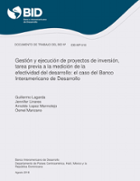Management and Execution of Investment Projects, the Task Prior to the Measurement of Development Effectiveness: The Case of the Inter-American Development Bank
Date
Aug 2018
The literature on development effectiveness has traditionally focused on the ex-post analysis of projects. While this is the appropriate method of measuring benefits, a previous step must be taken as a forerunner to good ex-post evaluation: the measurement of the efficiency in the execution of investment projects. This document aims to identify the determinants of good execution. Unlike previous studies, the current study analyzes execution using a project life cycle approach. Using an Inter-American Development Bank (IDB) database with information from various departments, the authors identify the factors that are associated with faster or slower disbursement on several stages of the projects’ life cycle. The basic premise is that the duration of an investment project– that is, the days elapsed from its approval to its final disbursement– is associated with preparation and execution-related factors as well as exogenous country factors. There is evidence that a sound macroeconomic and fiscal environment in countries is important for the purposes of good execution. Moreover, the authors find that delays in project planning and execution substantially extend project lives. These findings suggest the need to continue to improve efficiency in these areas. Finally, the authors find differences in project life cycles that are associated with delays caused by the projects’ executing units.




